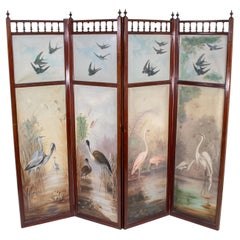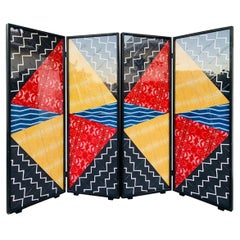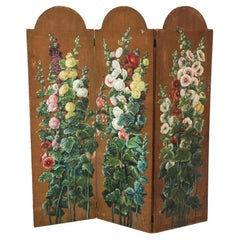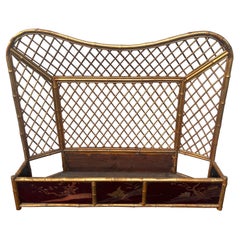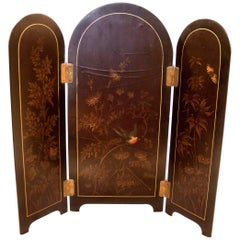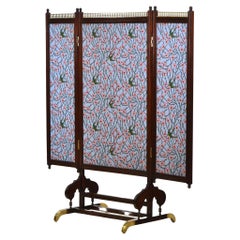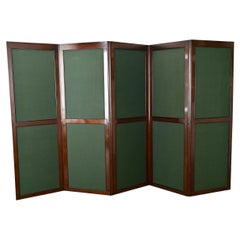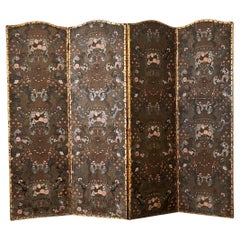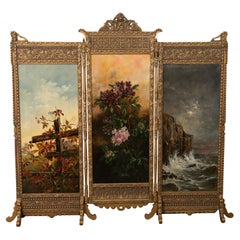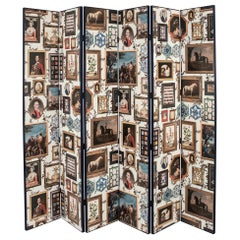Aesthetic Movement Screens and Room Dividers
In 1880, polymath designer William Morris declared: “If you want a golden rule that will fit everybody, this is it: Have nothing in your houses that you do not know to be useful or believe to be beautiful.” His words encapsulated the Aesthetic Movement, which prized beauty above all and blurred the lines between fine art and the decorative arts, particularly through lavishly crafted furniture pieces.
The Aesthetic Movement, whose major proponents included author Oscar Wilde, flourished from the 1860s to the 1880s and was mostly popular in England and the United States. Design expositions like the 1876 Centennial International Exhibition in Philadelphia, as well as the publishing of how-to books for interior design, helped disseminate Aesthetic Movement bedroom furniture, serveware, coffee tables and other items, especially to the middle class.
The establishment of new art museums, art clubs and a rising passion for collecting at the time contributed to a growing appreciation for art. Morris’s founding of Morris & Co. in 1862 and the commercializing of this “cult of beauty” by the Liberty store in London, starting in the late 19th century, further disseminated the idea of a domestic space that was thoughtfully and floridly designed.
Leading Aesthetic Movement furniture designers included E.W. Godwin, who drew on Japanese influences and whose work reflected a wider enthusiasm for imported East Asian art. British designer Christopher Dresser created textiles, ceramics and more that were also inspired by Japanese decorative art but were representative of additional diverse design sources that ranged from Egypt to Mexico.
The Aesthetic Movement’s eclecticism resulted in dazzling interiors. Japanese fans were positioned on Renaissance-inspired cabinets with brass hardware, while mantels made of rich walnut or finely carved ebonized wood and adorned with painted Minton tiles mingled with cast-iron chairs against a backdrop of floral wallpaper. In 1881, in New York City, stenciled checkerboard motifs and painted floral murals could be found under an opalescent glass chandelier in a luxurious dressing room designed by German émigré cabinetmaker-decorator George Alfred Schastey. Amid the rise of the industrial age, the style’s promotion of art in everyday life would inform the Arts and Crafts Movement and Art Nouveau.
Find a collection of antique Aesthetic Movement seating, tables, decorative objects and other furniture and antiques on 1stDibs.
Mid-19th Century English Antique Aesthetic Movement Screens and Room Dividers
Canvas, Glass, Mahogany
1990s North American Aesthetic Movement Screens and Room Dividers
Plexiglass, Wood
1870s American Antique Aesthetic Movement Screens and Room Dividers
Canvas, Pine, Paint
19th Century French Antique Aesthetic Movement Screens and Room Dividers
Bamboo, Giltwood, Lacquer
1860s English Antique Aesthetic Movement Screens and Room Dividers
Brass
19th Century British Antique Aesthetic Movement Screens and Room Dividers
Silk, Walnut
Late 19th Century French Antique Aesthetic Movement Screens and Room Dividers
Paint
19th Century English Antique Aesthetic Movement Screens and Room Dividers
Cotton, Mahogany
19th Century Spanish Antique Aesthetic Movement Screens and Room Dividers
Metal
19th Century French Antique Aesthetic Movement Screens and Room Dividers
Ormolu
Early 19th Century Italian Antique Aesthetic Movement Screens and Room Dividers
Bronze, Ormolu
Early 19th Century English Antique Aesthetic Movement Screens and Room Dividers
Brass
19th Century French Antique Aesthetic Movement Screens and Room Dividers
Oak
1870s French Antique Aesthetic Movement Screens and Room Dividers
Brass
17th Century Dutch Antique Aesthetic Movement Screens and Room Dividers
Tapestry
19th Century Italian Antique Aesthetic Movement Screens and Room Dividers
Leather, Canvas, Paint
Mid-19th Century French Antique Aesthetic Movement Screens and Room Dividers
Canvas
19th Century British Antique Aesthetic Movement Screens and Room Dividers
Brass
20th Century Aesthetic Movement Screens and Room Dividers
Gold Leaf, Silver Leaf
1880s American Antique Aesthetic Movement Screens and Room Dividers
Gold Leaf
21st Century and Contemporary American Aesthetic Movement Screens and Room Dividers
Wood, Paper
1870s Moroccan Antique Aesthetic Movement Screens and Room Dividers
Mother-of-Pearl, Wood
Late 19th Century European Antique Aesthetic Movement Screens and Room Dividers
Fabric, Oak
1920s French Vintage Aesthetic Movement Screens and Room Dividers
Canvas, Paint
Late 19th Century French Antique Aesthetic Movement Screens and Room Dividers
Wood
Late 19th Century English Antique Aesthetic Movement Screens and Room Dividers
Walnut
19th Century European Antique Aesthetic Movement Screens and Room Dividers
Textile, Wood
